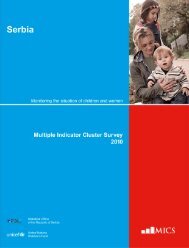Kosovo non-majority communities within the primary and ... - OSCE
Kosovo non-majority communities within the primary and ... - OSCE
Kosovo non-majority communities within the primary and ... - OSCE
You also want an ePaper? Increase the reach of your titles
YUMPU automatically turns print PDFs into web optimized ePapers that Google loves.
puts <strong>non</strong>-Albanian mo<strong>the</strong>r tongue students at a disadvantage. As highlighted by <strong>Kosovo</strong>Bosniak <strong>and</strong> <strong>Kosovo</strong> Turk students in Prizren, while <strong>the</strong> Ministry of Education has developeda curriculum for <strong>the</strong> second elective Albanian language, school-books have not been printed<strong>and</strong> are not available. Instead, teachers <strong>and</strong> students are provided with textbooks for Albanianmo<strong>the</strong>r tongue learners that are too complex <strong>and</strong> are not used in practice. In <strong>the</strong> <strong>primary</strong>school of Dobrushë/Dobruša (Istog/Istok), <strong>the</strong> situation is worse, considering that <strong>the</strong>re is nota single book of Albanian for <strong>Kosovo</strong> Bosniak students of any grade. According to <strong>Kosovo</strong>Bosniak students <strong>and</strong> parents in <strong>the</strong> Pejë/Peć region, Albanian language lessons are of goodquality, but insufficient in number <strong>and</strong> frequency to enable a good comm<strong>and</strong> of <strong>the</strong> language.<strong>Kosovo</strong> Bosniak secondary school students not fluent in Albanian cannot benefit ofinternship opportunities available for <strong>Kosovo</strong> Albanian <strong>within</strong> private firms of <strong>the</strong> region.Following <strong>the</strong>ir education, <strong>the</strong>y will have difficulties to work in Albanian speakingenterprises, even in <strong>the</strong>ir areas of expertise.The social environment <strong>and</strong> socialization opportunities provided by contacts with peers of <strong>the</strong><strong>Kosovo</strong> Albanian community play a key role in contributing to a successful learning of itslanguage. For instance, in Pejë/Peć <strong>Kosovo</strong> Bosniak children who do not come fromethnically mixed villages where <strong>the</strong> Albanian language is predominant have more difficulties<strong>and</strong> fewer opportunities to learn this language. Teachers propose summer courses ofAlbanian language to help catching up this deficit, as additional Albanian language classes<strong>within</strong> regular teaching hours would pose an excessive burden on <strong>the</strong>se students. However,<strong>the</strong>re would be no overburden if elective official language classes were an obligatoryteaching subject. <strong>Kosovo</strong> Turk students in Gjilan/Gnjilane learn Albanian from mo<strong>the</strong>rtongue teachers. At <strong>the</strong> end of secondary education, <strong>the</strong>y are well integrated into <strong>the</strong> <strong>Kosovo</strong>Albanian society <strong>and</strong> have a fair comm<strong>and</strong> of <strong>the</strong> Albanian language. None<strong>the</strong>less, this resultseems to be linked to socialization factors (such as physical proximity to <strong>and</strong> daily interactionwith <strong>Kosovo</strong> Albanian peers both in private <strong>and</strong> public spaces) ra<strong>the</strong>r than indicating anintrinsic good quality of <strong>the</strong> formal Albanian language education. Two Albanian languageclasses per week would be insufficient without supplementary social learning opportunities.During <strong>the</strong> <strong>primary</strong> school age, poor knowledge of each o<strong>the</strong>r’s languages seriously limitsinteraction between <strong>Kosovo</strong> Turk <strong>and</strong> <strong>Kosovo</strong> Albanian children. <strong>Kosovo</strong> Turk students donot speak fluent Albanian <strong>and</strong> find it difficult to engage in daily activities with <strong>Kosovo</strong>Albanian children. The situation improves during secondary education, when increasedknowledge of <strong>the</strong> Albanian language favours interaction <strong>and</strong> socialization also beyond schoolpremises. During this phase, <strong>Kosovo</strong> Turk male students undertake joint activities (such assports <strong>and</strong> o<strong>the</strong>rs) with <strong>Kosovo</strong> Albanian colleagues more frequently than <strong>the</strong>ir femalecolleagues. This determines a visible gap in Albanian language skills acquired by <strong>Kosovo</strong>Turk school boys <strong>and</strong> girls, respectively, leaving girls more exposed to <strong>the</strong> risk of exclusion.The Serbian <strong>and</strong> <strong>Kosovo</strong> curricula equally fail to provide students with <strong>the</strong> opportunity tolearn <strong>the</strong> o<strong>the</strong>r official language. In this context, future generations of <strong>the</strong> two largest<strong>communities</strong> will be unable to communicate with each o<strong>the</strong>r (o<strong>the</strong>r than in foreignlanguages). In <strong>the</strong> future <strong>the</strong> <strong>Kosovo</strong> civil service is likely to be composed of civil servantsunable to speak both official languages. Therefore, <strong>the</strong> implementation of <strong>the</strong> law on <strong>the</strong> useof languages <strong>and</strong> <strong>the</strong> equal use of <strong>the</strong> official languages is at risk. The only exception to thisnegative pattern is noticeable in Dragash/Dragaš, where Serbian-curriculum Gorani studentsare being taught two optional Albanian language classes per week in <strong>the</strong> grades 3-8.6. CONCLUSIONS AND RECOMMENDATIONS23
















